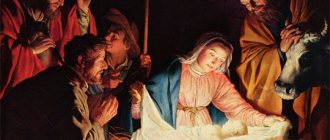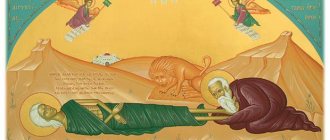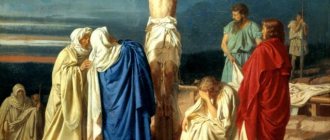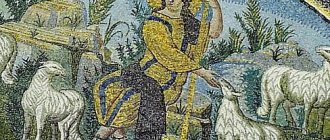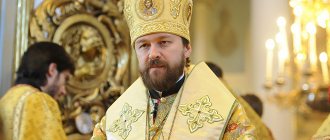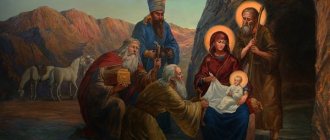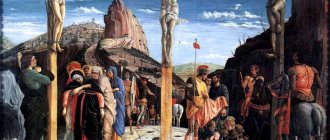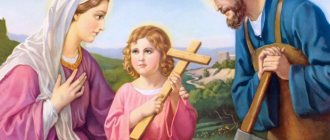Bible Questions and Answers
Published 10/15/2013
When exactly, on what day of the week, was Jesus Christ crucified according to the Bible? The Gospel of John says that Jesus was crucified on the eve of Easter, while other Evangelists say that Jesus Christ was crucified on Easter itself.
Answer:
When Jesus died according to John
John: “Then it was the Friday before Easter, and it was six o’clock . And Pilate said to the Jews, “Behold, your King!” (John 19:14).
"At nine o'clock" ...
To summarize, we get: neither Matthew nor Luke indicate the hour of the crucifixion; John places the crucifixion at a time after the sixth hour, Mark - at the third hour.
All the evangelists, except John, note darkness from the sixth hour to the ninth hour.
Matthew places the moment of death at “about the ninth hour,” Mark – “at the ninth hour,” Luke and John do not indicate.
"Jewish" time
It is naive to believe that all the evangelists used the time we are accustomed to when testifying, that is, according to their texts, the crucifixion took place according to Mark - at 15:00, according to John - at 18:00, darkness on Earth lasted from 18:00 to 21:00, and death occurred at 21:00.
But you can also consider the morning hours...
The most elementary explanation for the fallacy of this hypothesis can be the fact that no one would have noticed the onset of darkness from 18:00 to 21:00, since the Sun at that time had long been below the horizon.
Dawn in shackles
“When the morning had come, all the chief priests and the elders of the people had a meeting concerning Jesus, to put Him to death...” (Matthew 27:1).
Having condemned the Savior to death, the high priests, scribes and other members of the highest court of Israel, the Sanhedrin, nevertheless tried to relieve themselves of the burden of responsibility for outright murder. They sent Him to the representative of the Roman government then operating in Judea, procurator Pontius Pilate.
Finding no guilt in the actions of Christ, the Roman protege sent Him to King Herod Antipas, who nominally ruled Galilee at that time. Herod, first of all, longed for miracles from the Savior. However, without waiting for anything and without even hearing a single word from the Lord, Herod, together with his court, outraged Him, laughed at Him, dressed Him in light clothes as a sign of innocence, and sent Him back.
Christ on trial before Pilate
By the time the Savior was again brought to the Roman governor, many people had gathered near his house - the praetorium. Everyone was waiting to see what the final verdict would be. Pilate came out to those gathered and declared that he did not find any guilt behind Christ, just as King Herod did not find it. Trying to soften the crowd's discontent, he even suggested punishing the Lord, but then letting him go. However, this was not what the restless crowd, incited by the elders, expected. The last thing that Pontius Pilate could offer was to release Christ in honor of the Easter holiday, since such a custom existed among the Jews. However, he failed to do this either; the crowd demanded the release of another - the robber Barabbas.
Having presented both to the last public court, Pilate still tried to tip the scales in favor of Christ, but all this was in vain. Incited and blinded by their “teachers,” the people of Israel again and again demanded that Christ be crucified, reaching in their demand the terrible words: “His blood be on us and on our children” (Matthew 27:25).
What could Pilate do? Wash his hands and send Christ to execution, which is what he actually did.
There are many legends associated with the Way of the Cross of Christ
The Savior was forced to carry the cross to the place of execution. According to legend, this is Mount Golgotha. If you visit Jerusalem, they will show you this mountain, but it is not at all a fact that it is the very place where Jesus was crucified.
G. Memling’s painting “Saint Veronica” depicts a board on which the face of the Savior appeared
There are several versions, and it is not a fact that at least one of them is correct.
There are many legends associated with the Way of the Cross of Christ. Here are just two of them:
- Veronica's Plat . The good Jewish woman Veronica wiped the blood and sweat from the face of Christ, after which the face of the Savior appeared on her scarf. Currently, several relics are known that claim to be called Veronica's board.
- The Eternal Jew . The Savior got tired along the way and asked a Jew named Agasferus for permission to lean against the wall of his house, but the owner insulted the Savior. Jesus Christ cursed this man with immortality. Now Agasfer is forced to wander around the world until the Second Coming.
These stories have a lot of variations and have been played out many times in works of art.
Ahasferus (Eternal Jew) - a man, according to legend, doomed to immortality for insulting Christ (drawing by G. Dore)
Christ was crucified between two thieves: the insane and the prudent
Let us turn to the text of the Gospel:
OK. 23:32-43
“They led two evildoers with Him to death. And when they came to a place called Lobnoye, they crucified Him and the villains there, one on the right and the other on the left...
One of the hanged villains slandered Him and said: “If You are the Christ, save Yourself and us.”
The other, on the contrary, calmed him down and said: “Or are you not afraid of God, when you yourself are condemned to the same thing? And we are condemned justly, because we accepted what was worthy of our deeds, but He did nothing bad.” And he said to Jesus: “Remember me, Lord, when You come into Your Kingdom!” And Jesus said to him: “Truly I tell you, today you will be with Me in Paradise.”
Fragment of the icon “The Prudent Robber”. Jesus crucified between two thieves
These two robbers were called Dismas and Gestas. This episode can be seen as one of the temptations of Christ. After all, at first glance, the robber says reasonable things: if you are God, then why are you hanging here for the amusement of your enemies?
But Christ, according to the biblical story, as we will see later, has other goals. That's why He doesn't listen to Gestas. The Savior also ignores the cries of people who are being sarcastic:
“Come down from the cross and we will believe.”
Although it is clear that these are empty promises. Faith is strengthened not by miracles, but by love and devotion. And the Roman soldiers, forgetting about the crucifixion of Jesus and the honor of the soldier, divided the Savior’s clothes.
How God died
The Gospel tells us that our Lord Jesus Christ was crucified on the cross. Historically, among the Jews of that time, this method of execution was considered the most shameful; only the most terrible inveterate villains were sentenced to it. Such a death was not only the most painful of all possible, but it was in full view of a large number of people who, until the last breath of the executed person, could mock and mock him in every possible way.
Through the death of Christ, man was reconciled with God
The cross on which the Lord was crucified was installed on Mount Golgotha. But the torment of Christ began much earlier - even before ascending the mountain, a crown of thorns was placed on His head, supposedly symbolizing the royal crown, and He was also scourged.
Important! Flagellation itself was considered a sufficient measure of punishment for many criminals, since not everyone survived it.
Apparently, Pontius Pilate nevertheless tried not to bring the matter to a shameful execution and hoped that the torment of Christ would be limited to scourging. This type of punishment was lashing with a leather whip made of five tails, with a lead ball tied to the end of each tail. The blows of such a whip were so traumatic that they tore the human body to the very bones. That is why, according to the laws of that time, only one type of punishment was provided. In the case of Christ, this law was violated, and after the scourging, which the Lord was able to survive, He was led to a shameful execution.
After all the preparations were completed, the soldiers nailed Christ to the Cross. To do this, His palms and soles were pierced, after which the Cross was installed vertically. At this time, the Lord prayed for his tormentors with the words: “Forgive them, Father, for they do not know what they are doing.”
Important! We must always remember these words of Jesus, because He sets us an example of how to treat our enemies - we should not hate them and take revenge, but we should forgive them.
Of course, it is difficult for mere mortals to comprehend such completeness of forgiveness, but at a minimum, every Christian should strive for this. And even if, due to our lack of faith, the full depth of Christian forgiveness is inaccessible to us, the minimum that we should do in relation to our enemies is not to return evil for evil. This is the cornerstone of the entire Orthodox faith.
Read about Christ:
- Suffering on the Cross of Jesus Christ
- Resurrection of Jesus Christ
The path traveled for everyone
Given over to execution, Christ suffered a lot before execution. The Savior was mocked, beaten and ridiculed by the Roman soldiers who were to accompany Him to the place of execution. Having placed a crown of thorns on the Lord’s head, its thorns digging into the flesh, and giving Him a heavy cross - an instrument of execution, they set out on the path to Golgotha. Golgotha or the place of execution was a hill to the west of Jerusalem, which could be reached through the city's Gate of Judgment. This is the path the Savior took, eventually passing it for all people.
On the way to the place of execution, Christ was accompanied by many people, both His enemies and friends. The women who followed the Lord earlier walked now, weeping and weeping for Him. However, the Savior told them not to cry for Him, but for themselves: “Daughters of Jerusalem! Weep not for Me, but weep for yourself and for your children, for the days are coming in which they will say: Blessed are the barren, and the wombs that have not given birth, and the breasts that have not nursed! Then they will begin to say to the mountains: fall on us! and the hills: cover us! (Luke 23:28-30). Thus, Christ predicted the future catastrophe of Jerusalem and all of Israel. (In 70 AD, Jerusalem was captured and completely destroyed by the troops of the Roman emperor Vespasian and his son Titus.)
When the Lord was completely exhausted from the weight of the cross and insults, Roman soldiers tore one man from the crowd - Simon of Cyrene and forced him to carry the instrument of execution for some time.
At Golgotha everything was already ready. The soldiers even prepared a special drink for those condemned to death - a mixture of sour wine, vinegar and other substances. This drinking put the crucified into a stupefied state, in which they partially did not feel pain. Together with the Lord, two more criminals awaited execution on the cross.
Jesus Christ preached in Judea, and the priests considered him a false prophet and decided to execute him
In the context of talking about the death of Christ, we will not dwell in detail on the details of His life. It's not that important now. Let's get down to the facts. A few years before our era, according to the Gospel story, an amazing man was born, about whom they would later say that He was the Son of God.
Article “John the Baptist” on hranitel.club
Until about the age of 30, almost nothing is known about Jesus Christ, but then He goes out to preach following the example of his relative, John the Baptist, whose disciples make up Jesus’ first audience.
The first disciples of Jesus Christ came to him from the disciples of John the Baptist.
There are different assessments of the person of Christ. They say that He:
- Prophet;
- A common person;
- Artifice;
- Man-god;
- Son of God;
- Archangel Michael.
We will adhere exclusively to the Orthodox interpretation. According to it, Christ became famous through miracles and sermons. He positioned himself as the true heir of the Jewish faith, while many Jews were not righteous enough in their devotion to God.
The preaching of Jesus Christ was displeasing to the high priests of Judea
The preaching of Christ was not something unique to Judea. In those years, it was under the rule of Rome, the temple was destroyed, and the Jews perceived these circumstances as terrible times in which the Messiah would appear. That is why there were enough such “messiahs” regularly.
However, according to the biblical account, it was Jesus Christ who became the problem for the high priests of Judea. They considered Him a false prophet and decided to achieve the death of Christ by any means.
